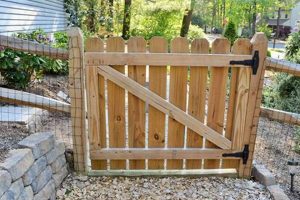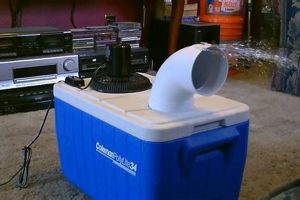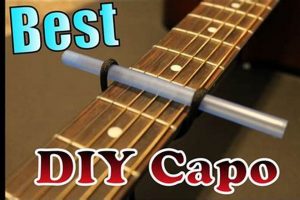A structure created using balloons affixed to a frame or line to form an archway is a popular decorative element for events. These constructions can range from simple, single-color designs to elaborate, multi-colored displays incorporating various balloon sizes and textures. As an example, individuals may construct this decorative piece for birthday parties, weddings, or corporate gatherings.
The appeal of these self-assembled decorations lies in their cost-effectiveness and personalization potential. Compared to professionally installed decorations, a do-it-yourself approach offers considerable savings. Furthermore, the ability to select colors, balloon types, and design elements allows for complete customization to match a specific theme or aesthetic. Historically, balloon arches have evolved from simple, symmetrical arrangements to more complex, organic shapes.
The subsequent sections will detail the materials required, the step-by-step construction process, and provide tips for achieving a professional-looking result. Considerations for structural integrity, balloon selection, and design principles will also be addressed.
Essential Considerations for Balloon Arch Construction
The following outlines crucial recommendations for a structurally sound and visually appealing balloon arch.
Tip 1: Balloon Size Consistency: Maintain uniformity in balloon inflation. Inconsistent sizes compromise the archs aesthetic and structural integrity. Use a balloon sizer for accurate inflation.
Tip 2: Structural Support Selection: Choose a robust support system appropriate for the arch’s size and location. Consider a metal frame for durability or a sturdy monofilament line for lightweight designs. Ensure the support system is securely anchored.
Tip 3: Balloon Quality: Opt for high-quality balloons to minimize breakage and helium leakage (if using helium). Latex balloons should be thick and consistent in color. Mylar balloons offer greater durability.
Tip 4: Adhesion Method: Employ appropriate adhesive methods for attaching balloons to the support structure. Balloon glue dots provide a secure and discreet bond. Avoid using strong adhesives that can damage the balloons.
Tip 5: Environmental Factors: Account for environmental conditions. Direct sunlight can cause balloons to burst. Extreme temperatures can affect balloon size and longevity. Indoor installations offer greater control over these factors.
Tip 6: Color Palette Coordination: Select a cohesive color palette that complements the event’s theme. Consider using a color wheel to identify harmonious color combinations. Gradient or ombre effects can add visual interest.
Tip 7: Secure Attachment Techniques: Implement secure methods for attaching the arch to its location. Weights or sandbags are recommended for outdoor arches to prevent displacement by wind. Ensure attachments are concealed for a polished appearance.
The successful construction of a visually striking and structurally sound balloon arch depends on meticulous attention to detail and adherence to best practices.
The subsequent section will cover troubleshooting common issues encountered during the construction process.
1. Materials
The selection of appropriate materials is paramount to the successful execution and visual impact of a do-it-yourself balloon arch. The structural integrity and aesthetic quality are directly influenced by the components chosen. Inferior materials can lead to premature deflation, structural collapse, and a diminished visual presentation. For instance, low-grade latex balloons are more susceptible to bursting during inflation or under environmental stress, while flimsy support structures may buckle under the weight of the balloons, causing the entire arch to fail. Consider a wedding planner constructing an outdoor balloon arch for a beach wedding; selecting weather-resistant balloons and a heavy-duty frame is crucial to withstand wind and sun exposure, ensuring the arch remains intact throughout the event.
Furthermore, the adhesive used to attach balloons significantly affects the final result. Inadequate adhesive can result in balloons detaching from the structure, creating unsightly gaps and compromising the arch’s overall shape. Conversely, using overly aggressive adhesives may damage the balloons or the support structure. For example, employing balloon glue dots, specifically designed for this purpose, provides a secure yet gentle bond, preserving the balloons’ integrity and preventing damage to the underlying frame. The choice of support structure also determines the arch’s overall shape and stability. Options range from flexible wire to rigid PVC pipes, each offering varying degrees of support and aesthetic possibilities. The selection must align with the intended design and the environmental conditions the arch will endure.
In summary, the materials employed represent a foundational element of a self-assembled balloon arch, directly influencing its durability, visual appeal, and overall success. Careful consideration of balloon quality, adhesive properties, and structural support is essential. Challenges can arise from inaccurate material assessment, but the understanding of these connections enables successful fabrication.
2. Inflation
Proper inflation is a critical component in the construction of a do-it-yourself balloon arch. The degree of inflation directly impacts the arch’s structural integrity and aesthetic appearance. Under-inflated balloons result in a sagging, uneven structure, while over-inflation can lead to premature bursting, compromising the arch’s overall stability and visual appeal. For example, if a balloon arch is intended for an outdoor event, consistent and appropriate inflation ensures each balloon contributes equally to the arch’s resistance against wind, preventing collapse. Conversely, improperly inflated balloons create weak points, increasing the likelihood of failure. Accurate inflation techniques and equipment, such as electric balloon pumps with pressure regulators, are, therefore, essential for consistent results.
The type of gas used for inflation also significantly affects the arch’s performance. Helium, while providing lift, is subject to leakage, requiring frequent replenishment, especially in warmer environments. Air, though not providing lift, offers greater longevity and cost-effectiveness, particularly when the arch’s design incorporates a support structure. Consider an elaborate indoor balloon arch for a corporate event; using air-filled balloons attached to a sturdy frame ensures the arch maintains its form throughout the event without the need for constant attention. Furthermore, the distribution of inflation across different balloon sizes is crucial for creating visually appealing patterns and achieving the desired arch shape. A gradual increase in balloon size towards the center of the arch, achieved through precise inflation, can create a more dynamic and a
esthetically pleasing appearance.
In summary, the process of inflation constitutes a fundamental element in creating a successful do-it-yourself balloon arch. Consistent, accurate, and appropriately managed inflation, along with careful consideration of gas type and distribution, directly affects the arch’s structural integrity, longevity, and visual impact. Challenges associated with inconsistent inflation can be mitigated through proper technique and equipment, contributing to a more durable and visually compelling final product.
3. Structure
The structural integrity of a do-it-yourself balloon arch is paramount to its success as a decorative element. The underlying framework directly dictates the arch’s shape, stability, and load-bearing capacity. The choice of materials for this frameworktypically wire, PVC piping, or monofilament linemust correlate with the intended size and complexity of the balloon arrangement. For instance, a large, freestanding arch requires a more robust PVC pipe frame to prevent sagging or collapse, whereas a smaller arch attached to a wall may utilize a lighter wire structure. Failure to adequately consider structural support can result in an unstable and visually unappealing final product. The spacing and arrangement of balloons on the structure are also critical. Densely packed balloons provide a fuller appearance but increase the overall weight, demanding a stronger support system.
Different structural designs offer varying aesthetic and functional properties. A symmetrical arch provides a classic, formal appearance, while an asymmetrical or organic design offers a more contemporary and dynamic look. The chosen structure also influences the ease of transportation and installation. Modular structures, composed of smaller, interconnected sections, allow for easier transport and assembly at the event location. The method of attaching balloons to the structure further contributes to the overall stability and visual coherence. Employing appropriate techniques, such as secure knotting or specialized adhesive dots, ensures that the balloons remain firmly in place throughout the duration of the event. The attachment points must be evenly distributed to avoid creating stress concentrations on the frame.
In summary, the structural component of a do-it-yourself balloon arch is inextricably linked to its overall success. The choice of materials, the design of the framework, and the method of balloon attachment are critical considerations. Overlooking structural integrity risks compromising the arch’s visual appeal, stability, and longevity. Understanding these principles enables the creation of aesthetically pleasing and structurally sound balloon arches that effectively serve their intended decorative purpose.
4. Design
Design, in the context of a self-assembled balloon arch, is not merely aesthetic consideration but a foundational element determining structural integrity and visual impact. The initial conceptualization directly influences material selection, construction techniques, and ultimately, the arch’s ability to fulfill its decorative purpose. For instance, a complex, multi-tiered design necessitates a robust support structure and precise balloon sizing, whereas a simpler, single-arch design offers greater flexibility in material choices and construction methods. A poorly conceived design can lead to structural instability, uneven balloon distribution, and a final product that fails to meet expectations. Therefore, the design phase requires careful planning and attention to detail.
The practical application of design principles extends beyond the overall shape and size of the arch. Color palettes, balloon textures, and the incorporation of additional decorative elements contribute significantly to the final aesthetic. A well-coordinated color scheme enhances visual appeal and complements the event’s theme, while the strategic placement of balloons of varying sizes and shapes adds depth and dimension. Consider the example of a balloon arch designed for a children’s birthday party; the incorporation of bright, contrasting colors and playful balloon shapes creates a festive atmosphere. Conversely, a balloon arch designed for a corporate event may employ a more subdued color palette and a streamlined design to project a professional image.
Effective design anticipates potential challenges and incorporates solutions to mitigate them. For example, outdoor installations require wind resistance considerations, such as securing the arch to a stable base or incorporating reinforced structural elements. The selection of weather-resistant balloons is also crucial to prevent premature deflation or damage from exposure to sunlight. In conclusion, design is an indispensable component of a successful do-it-yourself balloon arch. Careful planning, attention to detail, and a thorough understanding of design principles are essential for achieving a visually appealing, structurally sound, and long-lasting decorative element.
5. Assembly
Assembly constitutes the pivotal stage in the do-it-yourself balloon arch creation process, transforming individual components into a cohesive and visually appealing structure. Its execution directly impacts the arch’s stability, aesthetic coherence, and overall success as a decorative element. Effective assembly necessitates a systematic approach and a thorough understanding of the previously established design and structural considerations.
- Balloon Attachment Techniques
The method of affixing balloons to the support structure significantly affects the arch’s visual uniformity and long-term durability. Employing consistent knotting techniques or utilizing balloon adhesive dots ensures that balloons remain securely in place and evenly distributed. Inconsistent attachment leads to visible gaps and structural weaknesses, compromising the arch’s intended appearance. For example, a professional event decorator would use a standardized knotting procedure to maintain uniform tension and prevent balloon slippage.
- Framework Integration
The seamless integration of the balloon arrangement with the underlying support framework is crucial for structural integrity. Balloons must be attached in a manner that distributes weight evenly across the frame, preventing localized stress points and potential collapses. This often involves strategically positioning heavier or larger balloons near supporting elements. An amateur might neglect this aspect, resulting in an arch that sags or topples under its own weight.
- Sequence of Construction
The order in which the arch is assembled influences both the ease of construction and the final result. Assembling the arch in sections, then connecting them allows for better control over the overall shape and minimizes the risk of damaging already attached balloons. Attempting to assemble the entire arch in a single, continuous process often leads to errors and structural imbalances. Consider a construction crew assembling a bridge; they would build it section by section, not attempt the entire span at once.
- Adherence to Design Specifications
The assembly process must strictly adhere to the pre-determined design specifications, including balloon spacing, color patterns,
and overall dimensions. Deviations from the design can result in a visually disjointed and aesthetically unappealing arch. This requires constant monitoring and adjustments throughout the assembly process. A master builder follows the architects blueprints exactly to ensure the building comes out right.
In essence, the assembly phase of a do-it-yourself balloon arch represents the culmination of planning and preparation. The successful execution of this stage demands precision, attention to detail, and a steadfast commitment to the established design, ultimately determining the arch’s viability and visual impact as a decorative element.
6. Placement
Placement, in the context of a self-assembled balloon arch, assumes a role that extends beyond mere physical positioning. It influences visual impact, structural stability, and the overall effectiveness of the decoration within a given environment. A well-crafted arch, inappropriately placed, can diminish its aesthetic appeal and potentially create logistical challenges.
- Environmental Considerations
The surrounding environment exerts a significant influence on the suitability of a given location. Outdoor placements expose the structure to wind, sunlight, and temperature fluctuations, necessitating secure anchoring and weather-resistant materials. Conversely, indoor placements offer greater environmental control but may present spatial limitations or require adherence to specific venue regulations. A failure to account for these factors can lead to structural instability or a visually incongruous presentation.
- Spatial Dynamics
The available space and its relationship to the arch’s dimensions critically affect the overall visual harmony. An arch that is too large for its designated space can appear overwhelming and obstruct movement, while an arch that is too small may seem insignificant or disproportionate. Careful consideration of spatial dimensions is crucial for achieving a balanced and aesthetically pleasing composition. The arch can be used to change how people navigate an area. To do that, spatial dynamics is highly needed
- Focal Point Alignment
Strategic alignment of the arch with a designated focal point, such as an entrance, stage, or display, enhances its visual impact and draws attention to the intended area. Misalignment can detract from the focal point and create a sense of visual imbalance. Consider the deliberate placement of an archway to frame a wedding ceremony or to highlight a product launch at a trade show.
- Accessibility and Safety
Placement must prioritize accessibility and safety considerations. The arch should not obstruct pathways, impede emergency exits, or pose a hazard to individuals in the vicinity. Secure anchoring and careful attention to height and width clearances are essential for preventing accidents and ensuring unimpeded movement. For example, avoid positioning an arch in a high-traffic area where it is likely to be bumped or damaged.
The various facets of placement are intrinsically connected to the ultimate success of a do-it-yourself balloon arch. Thoughtful consideration of the environmental context, spatial dynamics, focal point alignment, and accessibility ensures that the arch not only fulfills its decorative purpose but also enhances the overall event experience. Neglecting these considerations undermines the arch’s effectiveness and potentially creates unforeseen challenges.
7. Longevity
The longevity of a do-it-yourself balloon arch represents a critical determinant of its overall value and effectiveness, particularly in relation to the effort and resources invested in its creation. Premature deflation, fading colors, or structural collapse diminish the visual impact and compromise the intended decorative purpose. Several factors influence the lifespan of a balloon arch, demanding careful consideration during the planning and construction phases. Material selection constitutes a primary determinant; high-quality latex balloons, for example, exhibit greater resistance to deflation compared to lower-grade alternatives. Furthermore, the method of inflation plays a significant role; air-filled balloons generally maintain their form longer than helium-filled balloons due to the smaller molecule size of air and its reduced rate of leakage. Consider a community event utilizing a balloon arch as a welcoming entrance; an arch that deflates within hours detracts from the celebratory atmosphere and undermines the organizers’ efforts. Therefore, maximizing longevity is paramount.
Environmental conditions exert a considerable influence on the lifespan of a balloon arch. Exposure to direct sunlight accelerates the degradation of latex, leading to fading colors and increased susceptibility to bursting. Temperature fluctuations can also affect balloon volume, causing expansion and contraction that weaken the material over time. Protecting the arch from extreme weather conditions, either through indoor placement or the use of protective coverings, can significantly extend its lifespan. For instance, a balloon arch constructed for an outdoor wedding ceremony necessitates measures to mitigate the effects of sunlight and wind to ensure it remains intact throughout the event. Moreover, the structural design and assembly techniques employed impact the arch’s ability to withstand stress and maintain its form over time. A well-supported frame and secure balloon attachments minimize strain on individual balloons, reducing the likelihood of premature failure.
In summary, longevity constitutes a crucial factor in the success of a do-it-yourself balloon arch, influencing its visual appeal, structural integrity, and overall value proposition. Factors such as material quality, inflation method, environmental conditions, and structural design collectively determine the arch’s lifespan. While inherent limitations exist regarding the longevity of balloon decorations, employing best practices in planning and construction can significantly extend the arch’s lifespan, ensuring it effectively fulfills its intended decorative purpose. The challenge lies in balancing cost considerations with the desire for extended durability, requiring careful evaluation of available materials and construction techniques.
Frequently Asked Questions
The following addresses common inquiries regarding the construction, maintenance, and expected lifespan of self-assembled balloon arches.
Question 1: What is the typical lifespan of a do-it-yourself balloon arch?
The lifespan varies significantly based on factors such as balloon quality, inflation medium (air vs. helium), and environmental conditions. Indoor arches using high-quality latex balloons inflated with air can potentially last for several weeks. Outdoor arches, particularly those exposed to direct sunlight or extreme temperatures, may only last for a few days or even hours.
Question 2: What is the most cost-effective method for constructing a balloon arch?
Utilizing air-filled balloons and a reusable frame (e.g., PVC pipe) generally presents the most economical option. Helium inflation incurs ongoing costs, and single-use frames contribute to waste and increased expenses.
Question 3: How does weather impact the structural integrity of a balloon arch?
Wind poses a significant threat to outdoor balloon arches, pot
entially causing structural damage or complete collapse. Direct sunlight accelerates latex degradation, leading to bursting and color fading. Extreme temperatures can also affect balloon volume, resulting in instability.
Question 4: Are there specific safety precautions to consider when constructing a balloon arch?
Ensure the arch is securely anchored to prevent tipping or collapse, particularly in outdoor settings. Avoid using metallic or conductive materials near electrical sources. Supervise children during construction to prevent ingestion of small parts.
Question 5: What type of support structure is recommended for a large, freestanding balloon arch?
A robust frame constructed from PVC pipe or metal tubing is generally recommended for large, freestanding arches. The frame should be designed to withstand the weight of the balloons and any potential environmental stressors.
Question 6: How can color fading in balloon arches be minimized?
Employing UV-resistant balloons and avoiding direct sunlight exposure can significantly reduce color fading. Consider using darker colors, as they tend to retain their vibrancy longer than lighter shades. A protective coating, though often impractical, may provide additional UV protection.
Understanding these common concerns facilitates the construction of more durable, visually appealing, and cost-effective balloon arches.
The subsequent section will explore advanced design techniques for creating more elaborate and visually striking balloon arches.
DIY Balloon Arch
This exploration of the DIY balloon arch encompasses critical facets from material selection and inflation techniques to structural considerations, design principles, assembly methods, placement strategies, and longevity factors. Understanding these elements enables the creation of visually appealing and structurally sound decorative pieces.
The construction of a DIY balloon arch represents a synthesis of artistic vision and practical execution. Its successful realization hinges on informed decision-making, meticulous attention to detail, and a commitment to quality craftsmanship. Continued refinement of techniques and a deeper understanding of material properties will undoubtedly lead to innovative advancements in this decorative art form.







